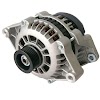Working principle of a Simple loop
generator
A simple coil of wire ABCD is mounted on shaft between two mangnetic poles as shown in Fig: (a). The two ends of the coil are connected to two slip rings, S1, S2 which are mounted on the same shaft. The slip rings are insulated from each other and from the shaft, these sliprings rotate along with the coil. The stationary brushes B1, B2 make a proper contact with rotating slip rings and lead the current induced in the coil to the external load resistance R. This arrangement constitute a simple loop generator.
Let us assume that the coil starts from the position shown in fig: (a) and rotates at a uniform velocity in counter clockwise direction. In its initial position the conductors AB and CD are moving parallel to the mangnetic lines of force hence, induced e.m.f. is zero as shown in Fig: (b).
As the coil rotates further (0 TO 90), however the conductors
begin to cut the magnetic lines of force and therefore, the e.m.f. induces in
the conductors according to the Faradays Law’s of Electromagnetic Induction.
The value of inducesd e.m.f. depends upon the lengths of the conductor, the
magnetic field strength and the speed at which the coil ratates. The conductor
has maximum e.m.f. induced at 90![]() position, because the conductor moving at
right angles to the flux.
position, because the conductor moving at
right angles to the flux.
In the next quarter revolution
i.e. from 90![]() to 180
to 180![]() , the induced e.m.f. varies from maximum to
zero gradually. During this half revolution, the flow of current is along
BAMLDCB, i.e. current through R is from M to L.
, the induced e.m.f. varies from maximum to
zero gradually. During this half revolution, the flow of current is along
BAMLDCB, i.e. current through R is from M to L.
In the next half revolution i.e.
from 180![]() to 360
to 360![]() , the variations in the magnitude of e.m.f.
are similar to those in the first half revolution, except the direction of
current path is reversed I.e. current flow along CDLM ABC and current through R
is from L to M.
, the variations in the magnitude of e.m.f.
are similar to those in the first half revolution, except the direction of
current path is reversed I.e. current flow along CDLM ABC and current through R
is from L to M.
It is understood that the current through external load R reverse its direction after every half revolution. It also must be understood the the current not only reverse its direction but also changes its mangnitude at every instant as shown in Fig: (b). Such a current is known as alternating current. The corresponding voltage is known as dynamically induced e.m.f.
For making the flow of current unidirection in external load circuit, the slip-rings are replaced by split-ring. The split-rings are made of conducting cylinder. which is cut in to two halves or segments insulated from each other and from shaft with (a thin mica sheet) insulating material as shown in Fig. The two ends of the coil are connected to these segments (Sg1,Sg2) and the brushes (b1,b2) placed over these segments.
Fig. shown that in the first half revolution of the coil, the current flow along BAMLDCB i.e. the brush b1 is in contact with segment Sg1 acts as the +ve terminal of the supply and brush b2 is in contact with segment Sg2 and acts as –ve terminal. In the next half revolution the direction of the induced current in the coil has reversed. But at the same time, the position of segments Sg1 and Sg2 have also reversed, with the result that brush b1 comes in contact with segment Sg2 which is now +ve and the brush b2 is in contact with segment Sg1 which is now –ve. Thus the current in the external load Ragain from M to L.This current is unidirectional as shown in Fig.(b).
The position of the brushes is so arranged that the change of segments from one brush to another takes place when the plane of the rotating coil is at right angles to the plane of the lines of flux, since in thise position the induced e.m.f. in the coil will be zero.
It should be noted that the current induced in the coil sides is alternating, but it becomes unidirectional in the external load Rdue to rectifying action of the split – ring known as commutator.
A pulsating direct current such as given ny a single coil generator is not suitable for most commercial purposes. However by employing a large number of coils and commutator segments, with the coils evenly distributed around the surface of the armature the voltage can be increased and may be kept constant.










0 Comments